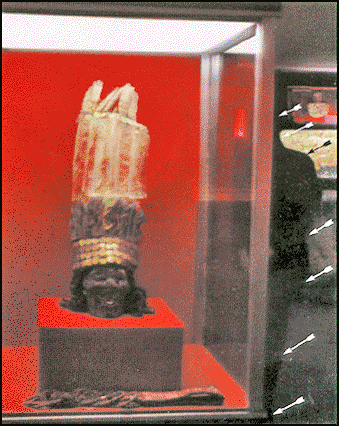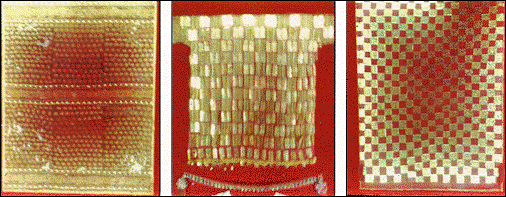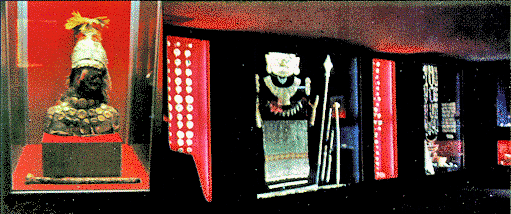Per the request of the author, the following submission is presented as received, without editorial revision. As part of Ancient American's open forum policy, readers may freely express themselves in their own words. Editor.
Nine-and-a-half feet tall is large for a human mummy, especially when it is found among today's diminutive Peruvians, whose average stature is just five feet. Understandably, professional anthropologists find tales of ancient giants amusing, but nothing more. Physical evidence may nonetheless exist to demonstrate that an oversized race of men did indeed dominate parts of prehistoric South America.
Oral stories of giant kings among the native Indians (principly [sic] the Aymara) looking for gold in Peru go back as far as the great Irish King Ophir mentioned in the Old Testament (I Chronicles 29: 3-9, Job 22: 24 Job 28: 16 Isa 12: 13).
That was a time when one could pick the gold nuggets out of the streams with your hands. The petroglyphs and legends of King Ophir still exist in Peru. As I said they [sic] are oral legends and no university has ever catalogued them. They are found like the petroglyphs along the Mississippi that pertain to the Burrows Cave. Mark Twain wrote about them and several others, but largely they have been ignored.
The same is true in Peru. There are petroglyphs along mountain paths and at the sites of ruins such as Tiahuanacu, but there are also petroglyphs right downtown Lima associated with the adobe pyramids. Nobody has chronicled these structures. There are several of them right in the middle of one of the major cities of the world. Now that may not satisfy you, but I can't help that. One would have thought that someone from the Discovery Channel would have produced a show on these structures. However, they haven't! It almost never rains in Lima and these adobe pyramid structures were built somewhere between 400 AD and 1000 AD. I enclosed a photo of one from a distance. Even now anthropologists refuse to make any connection between the old and new worlds before the arrival of Columbus.
The once famous King Ophir who lived before 600 BC and probably at the time of David the King, as mentioned in the Bible (because his craft was used in the temple) learned how to work in gold and overlay the walls and pillars, as is evident from the Biblical passages, from his travels in the ancient Americas. The three pictures included in this article are golden overlays that covered the interior walls of Inca Temples. These were not just designs stamped into the surface of the gold, but brilliant woven patterns made to appear like wallpaper tapestries. One can only imagine that this was the very same workmanship on the walls of the temple built under the direction of King David by the hands of the craftsmen of Ophir.
However, the craftsmanship of gold up-Nile was primitive and clumsy and not the craftsmanship necessary for the fine temple golden-woven wall paper used in the temple of Solomon. Lastly, there are impurities in the mining of all metals. These are the signatures for the source of the metal. One of the newest archeological techniques is to search for the source of metal at a dig sight based on the impurities of the metal. The Discovery Channel Program Curse of the Cocaine Mummy suggesting the drug link between Peru and ancient Egypt also suggested a signature metal connection between the two countries.
What should be painfully obvious to us today is that the secret of the ancient world of Palestine was not where one could mine gold in the desert, but that one could find gold by sailing on boats and how to navigate the oceans. There were no gold mines in the ancient deserts and all the gold that was used in the merchant traffic before Christ came from somewhere outside the Holy Land. That secret became almost a religion of its own by the time of the birth of Christ and was institutionalized by the time of Diocletian the Roman Emperor after Constantine, the editor of the Bible.
The secret at the time of Christ was that you could travel forty times farther in a day by ship than you could travel by camel . That concept by the time of Diocletian was refined to suggest that 1200 pounds of goods would double in price if taken three hundred miles overland. However, the same goods could be shipped almost anywhere in the known world for a third that cost.
The fraternal order of the Phoenician Pirates keep the secrets of where and how they had navigated the oceans. Their fingerprints exist around the world. These fraternal orders were secret orders with passwords, handshakes and signs and tokens. They had initiation rights etc. All of this secret banter centered over the secrets of how to navigate the oceans and where in the world was the treasure. It was not accident that Columbus looked to the West for gold. Others had been there before him and brought home wealth.
|
 |
Giant mummified head of an Inca King. Notice shadow of individual on the right of the glass case for perspective. Photos were frowned upon and had to be acquired discretely.
All photos © care of Glenn Kimball.
|
The mummy in the photo was clearly a giant man. There were two different mummies of Inca Kings in this private museum located at Jose's home. That is important because it down-plays the idea that maybe one of the kings was a mutation of some sort. Both men, would exceed the height of anyone we know in our world today.
Rumors of giant men walking the earth are not new at all. Genesis 6: 4 speaks specifically about them. Philo was very well aware of the classic traditions of the giants. Philo was a Jew who lived in Alexandria from 20 BC to the beginning of the Jewish wars in 66 AD. It is amazing to understand that he wrote his extensive works during the lifetime of Jesus and not very far away.
Those scholars who have naively suggested that there was no one else writing about Jesus during his lifetime except Josephus are lazy people indeed. Philo was one of the sources for the movie "The Ten Commandments". Director Cecil B. Demille did something very unusual in order to gain credibility for his movie. He opened the epic by appearing on a curtain-clad stage and told the world his historical sources for his version of the tale of Moses. One the of three principle sources was Philo.
Philo lived among thousands Jews in Alexandria during the lifetime of Christ. Alexandria was at the mouth of the Nile River and was the seat of learning for the world. It was a major merchant port...all issues making it larger than Rome by several times. Perhaps there were almost as many Jews in Egypt at the time of Christ as there was in Palestine.
At that time the Greeks dominated Egyptian culture and religion. The immediate proceeding ten pharaohs prior to the time of Philo couldn't even speak the Egyptian language with the exception of Cleopatra. After the conquest of Egypt by Alexander the Great Egypt and especially Alexandria the populace wrote slept and ate Greek culture and lore.
It should be no surprise that Philo was well aware of the legends and histories of the Giants. Philo was emphatic on this point when he said, "He utters no fable whatsoever respecting the giants; but he (God) wishes to set this fact before your eyes, that some men are born of the earth, and some are born of heaven, and some are born of God: those are born of the earth who are hunters after the pleasures of the body." The most critical point of this entire discussion of Philo and the Giants is that Philo mentions King Ophir in his specific notes relating to the giants in the ancient world. Either Philo thought King Ophir was one of the giants himself, which is unlikely, or Philo knew of the connection between the Peruvian traveler Ophir and the giants in the Americas. If the latter is true then the mummified kings depicted in this article take on even greater significance. Clearly there were giant kings in Peru. Who knew about these giant kings still remains speculative. However, it is amazing to suggest that Philo himself may have made that connection by the time of Christ.
I had no dating for the Peruvian Kings themselves. This was a private gold museum and not likely to allow me, or anyone else for that matter, to do any testing that might threaten the ownership of this golden treasure.
Part of me wants to think of these particular kings as living long after the time of Ophir somewhere around a thousand AD. Of course that would ruin the tale of the connection between King Ophir of the Bible and these mummies. The state of the mummy coincide with the tales of the Incas in one thousand AD. However, I have found after this discovery many mummified remains in Peruvian museums and many of the oldest dating from long before 600 AD were in exactly the same state of decomposition. I was relieved that the story of Ophir and these mummies remains intact.
The actual mummified head of the crowned king in the photograph is almost twice as large as my own and I wear the largest hat of anyone in my acquaintance. When we were invited to the private gold museum to begin with I was expected to be dazzled by gold. However, it dawned on me the minute I walked through the door that the size of the head, and indeed his whole body, was the unique feature of this king. The gold was impressive, but the size of the man was something more impressive than gold.
 |
|
Golden blankets and body tunic all woven from extremely fine gold threads to create these coverings fit for a king. Photos © Glenn Kimball.
|
The golden tunic that hung on the wall was made of spun gold. This was the first time in my life I had seen gold woven into a fabric for clothing. The tunic was over eight feet tall and tailored in such a way as to suggest that it was not intended to drag on the floor behind a king, but rather to hang straight down to the floor and no further. That made the tunic itself a measuring device for the original height of the giant king. It was shocking to imagine a man who could first wear this tunic without looking like a small child playing with his mother's clothing and secondly it was shocking to imagine the shear weight of the garment. The golden necklace at the foot of the tunic would have hung to the floor around the neck of anyone I know. The golden shoulder shield in the photograph was almost twice the size of shoulder pads used by professional football players.
There was also a set of golden gloves whose hands and fingers extended from the wrist to the tip of the middle finger about twelve to fourteen inches. I couldn't tell exactly because they were kept behind security glass.
|
|
Second mumified [sic] head of a giant man richly decorated in gold headgear and body covering. Right: Interior view of the private museum revealing an arrary [sic] of golden artifacts. Photos © Glenn Kimball.
|
It is important to note that this gold museum is private and not open to the public. Perhaps this is the only way precious golden relics like this could ever have been preserved. The governments of South America have often plundered the wealth of their own history. Many times the leaders of governments would plunder artifacts because these would be the treasures least missed by the people. It is horrifying to imagine how many precious things have been melted down into bars and sold for spot prices on the world market just to line the pockets of the greedy who should have been the ones to protect the artifacts to begin with. One can only imagine how many artifacts were melted by Cortez when he pillaged the great temple artifacts and writings of Montezuma in Mexico in the fifteen hundreds. The rumors in Spain were that Cortez could have built a bridge home to Spain from the Gold of Montezuma. Of course that is not literal, but figurative. Most of the world's best estimates of how much gold there is in world circulation suggest that one could fit all the gold in a two car garage! That makes the gold in this museum even more amazing.
Someone should have asked the question long ago, why did Cortez expect to find gold in the Americas in the first place? Why did the crew on the boats of Columbus expect to find gold? Why did the marauding Spaniards kill eight million native American Indians looking for gold. The truth is that the royal families of England and Spain had spoken as far back as King Arthur in 530 AD that their "treasure house" was located in the "Mericas" (Source for this statement needed Landaff Charters from the sixth century).
The German who suggested that we named the Americas after Amerigo Vespucci recanted his story when he found the tales of the "Mericas" stars which lead the way to the "promised land".
Regardless of the date the actual discovery or age of golden-clad giant kings in Peru the story still suggests something well beyond our common anthropological tales. Where were the anthropologists when I was traveling Lima in the sixties? Why haven't they caught up to this find in the last thirty years? I wonder if I am that good an archaeologist or that they are that bad. Sadly, I think the latter to be the case.
by Glenn Kimball, Ph.D
Ancient American, Volume 5, Issue #34, pages 36-38



